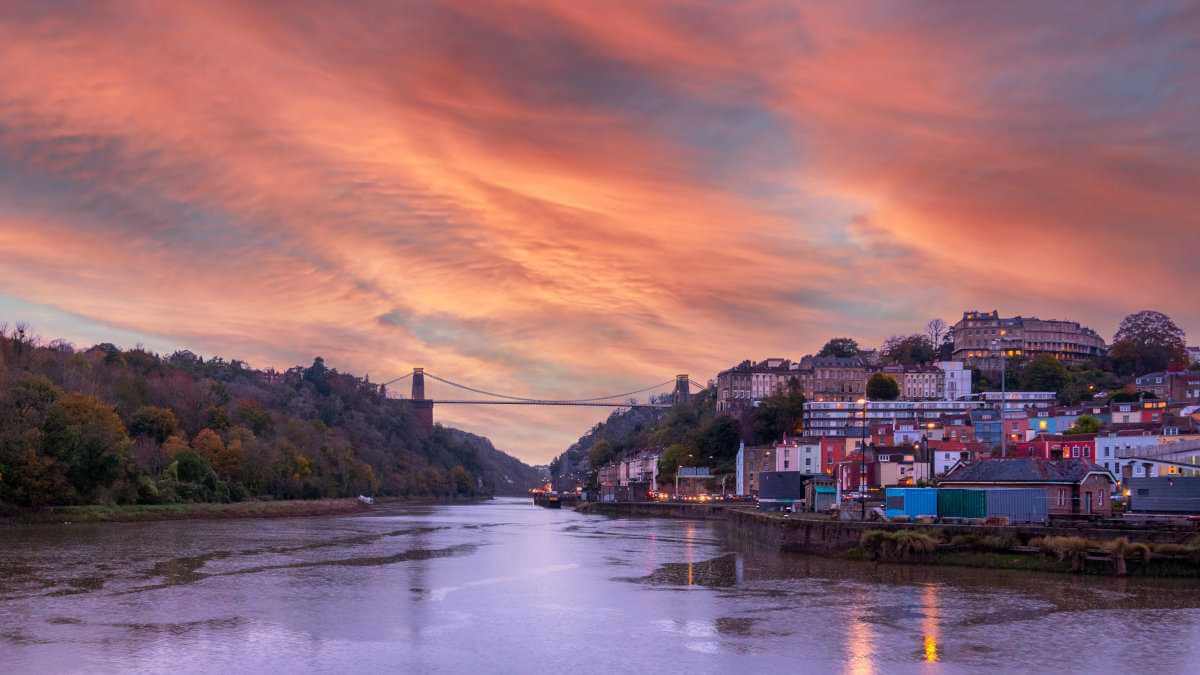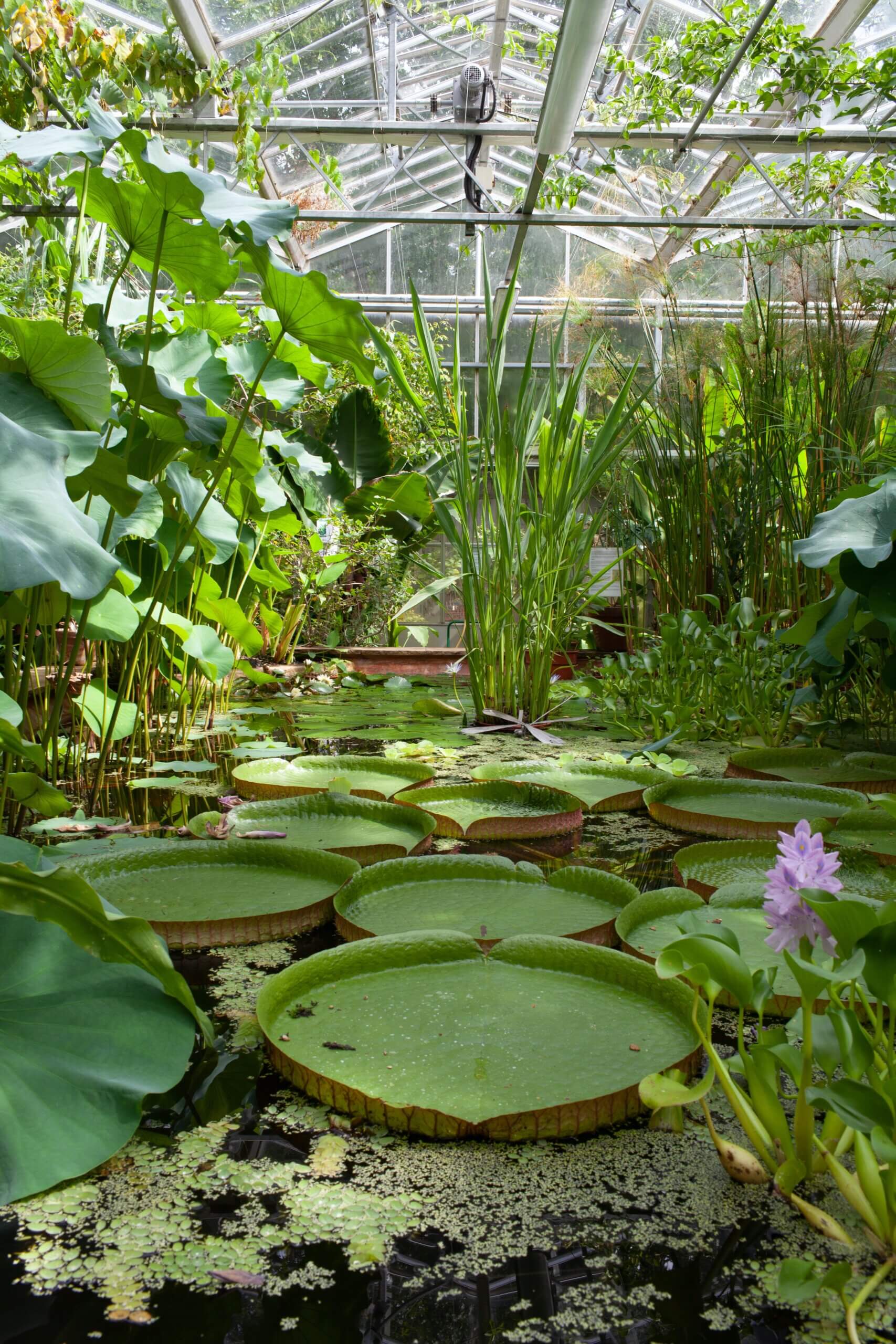*FYI - this post may contain affiliate links, which means we earn a commission at no extra cost to you if you purchase from them. Also, as an Amazon Associate I earn from qualifying purchases. Check out our Privacy Policy and Disclosure for more info.
From its iconic suspension bridge and hot air balloon festival to amazing street art and museums, Bristol is a truly unique city with much to offer visitors.
This vibrant (and large!) city is tough to explore in a day. Unlike more compact destinations in England like Bath or Windsor, Bristol really needs a few days at least for you to do it justice.
Not to worry though – we have a handy list of Bristol must-sees to help you get started.
In this post, we’ll be sharing our top picks for places to visit in Bristol, including the most beautiful buildings, ships and neighbourhoods.
We hope you enjoy learning about this exciting destination and be sure to let us know in the comments which Bristol must-sees we should add to our list!
Clifton Suspension Bridge
Sitting on the cliffs of the Avon Gorge is the Clifton Suspension Bridge, known as THE symbol of Bristol and one of the most popular Bristol attractions for visitors who walk across to enjoy the views made famous by countless Bristol postards.
This bridge crosses the Avon River and Avon Gorge to connect Bristol with the town of Leigh Woods. It opened in 1864 and has since always operated as a toll bridge, with the money from the tolls used to maintain it.
A short walk up the hill on the Bristol side of the bridge is the Clifton Observatory for photos of the bridge (like the one below) as well as a natural limestone cave called The Giant’s Cave.
Fun fact: This bridge also happened to be the site of the first modern bungee jump in 1979, a feat which involved a group of students from Oxford, who did the jump with tophats, tails, and champagne. It’s a pretty wild story.
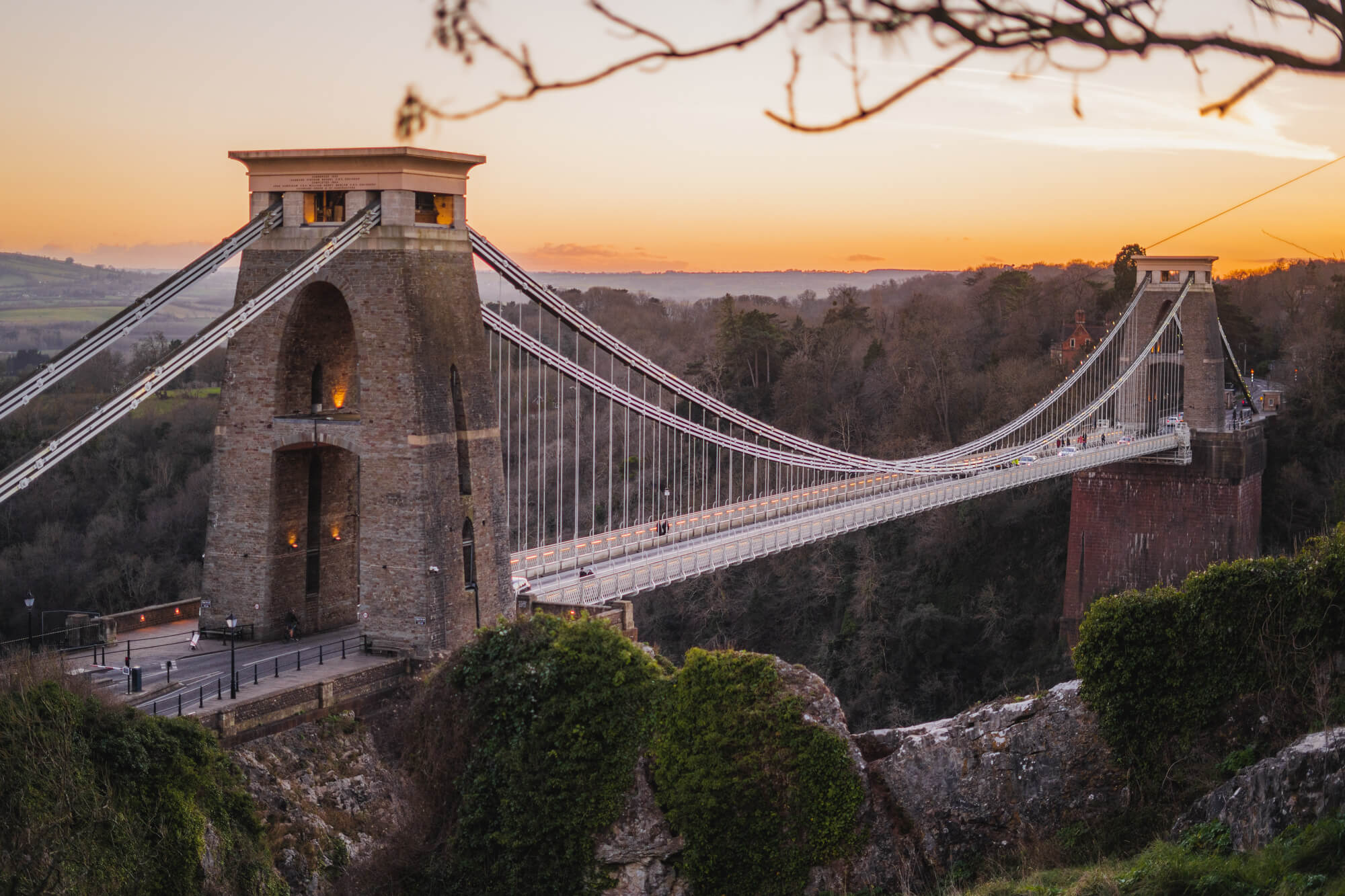
Clifton Village
The area next to the Clifton Suspension Bridge is called Clifton Village, and it’s a charming neighbourhood of Bristol well worth exploring.
As well as the bridge and Clifton Observatory, this suburb is home to beautiful Georgian architecture, as well as many independent shops and boutiques, making it one of the most popular shopping destinations in Bristol. The variety of excellent cafés, pubs and restaurants are also ideal when you need a break from shopping! We had an especially good meal at Fishers.
Other places worth visiting in Clifton include the Bristol Zoo Gardens, the Victoria Rooms cultural centre and the Redgrave Theatre. There are also a number of open park areas next to the Avon Gorge that are perfect for walking, having a picnic and just enjoying the outdoors.
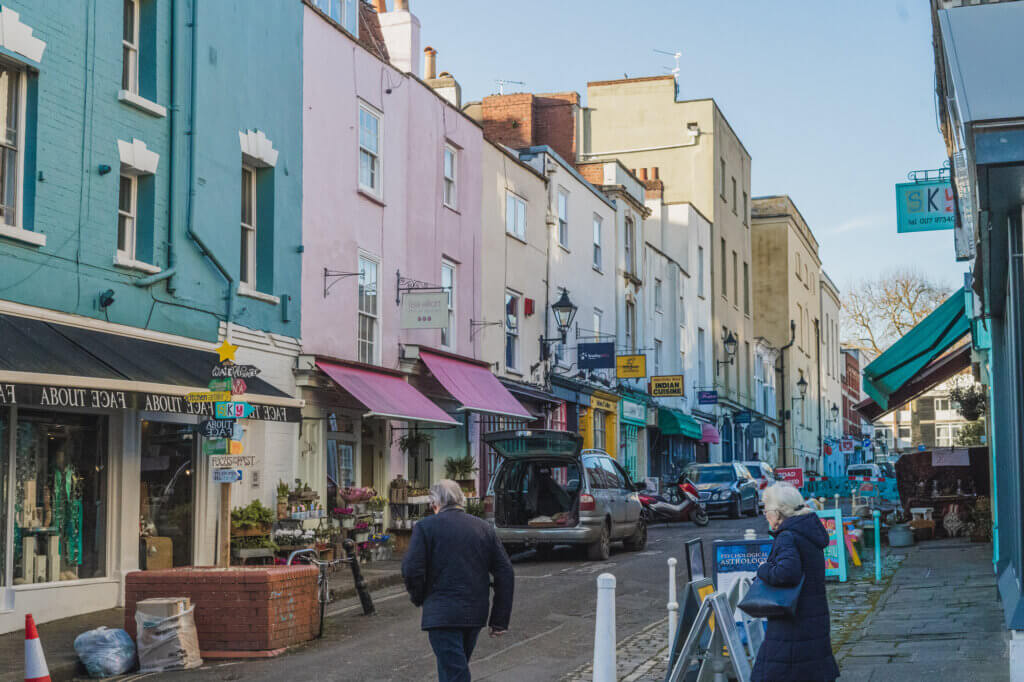
Bristol Museum and Art Gallery
One of the best places to visit in Bristol to learn more about the history of the city is the Bristol Museum and Art Gallery. Even better, it’s totally free!
Housed in a Grade II Listed Edwardian Baroque building, visitors can explore collections of geology, zoology, archaeology, Egyptology, Eastern Art, Modern Art and the history of Bristol. In particular, there are many modern paintings of Bristol itself, including work by Bristol local Banksy.
The Bristol Museum and Art Gallery also hosts regular workshop events as well as temporary exhibitions throughout the year, so there’s always something unique to discover.
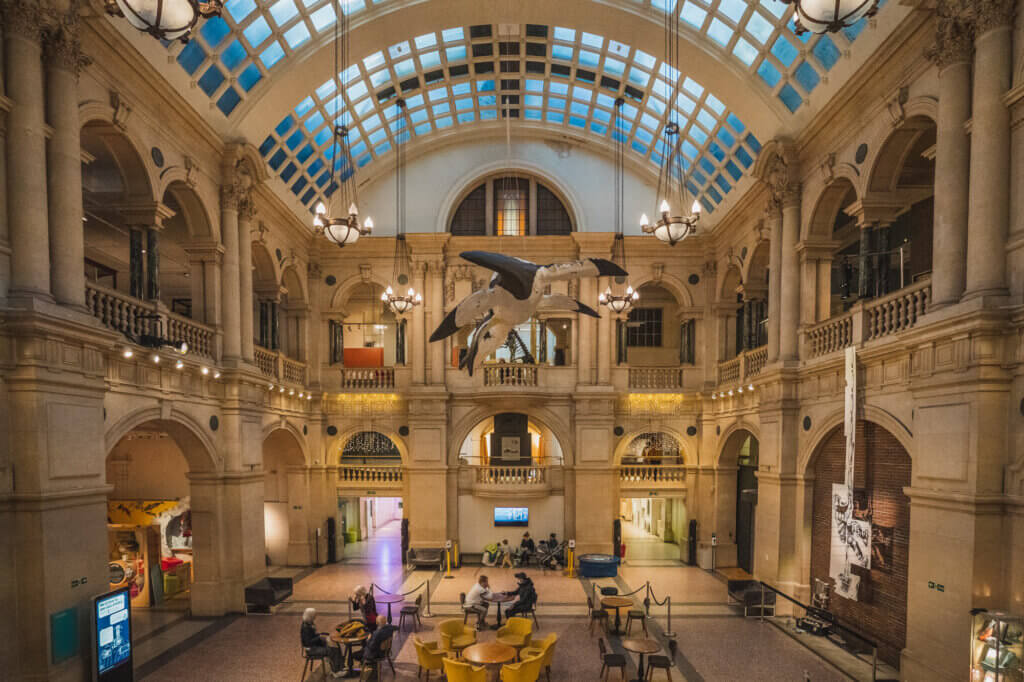
Bristol Cathedral
The gorgeous and fascinating Bristol Cathedral is one of the top Bristol tourist attractions, partly because it’s the only hall church Cathedral in the country. That means the aisles are the same height as the choir, which is usually placed higher in a cathedral.
Bristol Cathedral was originally founded as St Augustine’s Abbey in the 12th-century but became the Cathedral Church of the Holy and Undivided Trinity after the dissolution of the monasteries. There’s a historic organ and some beautiful stained-glass windows to admire, although many of these had to be replaced after the bombing of Bristol in WWII.
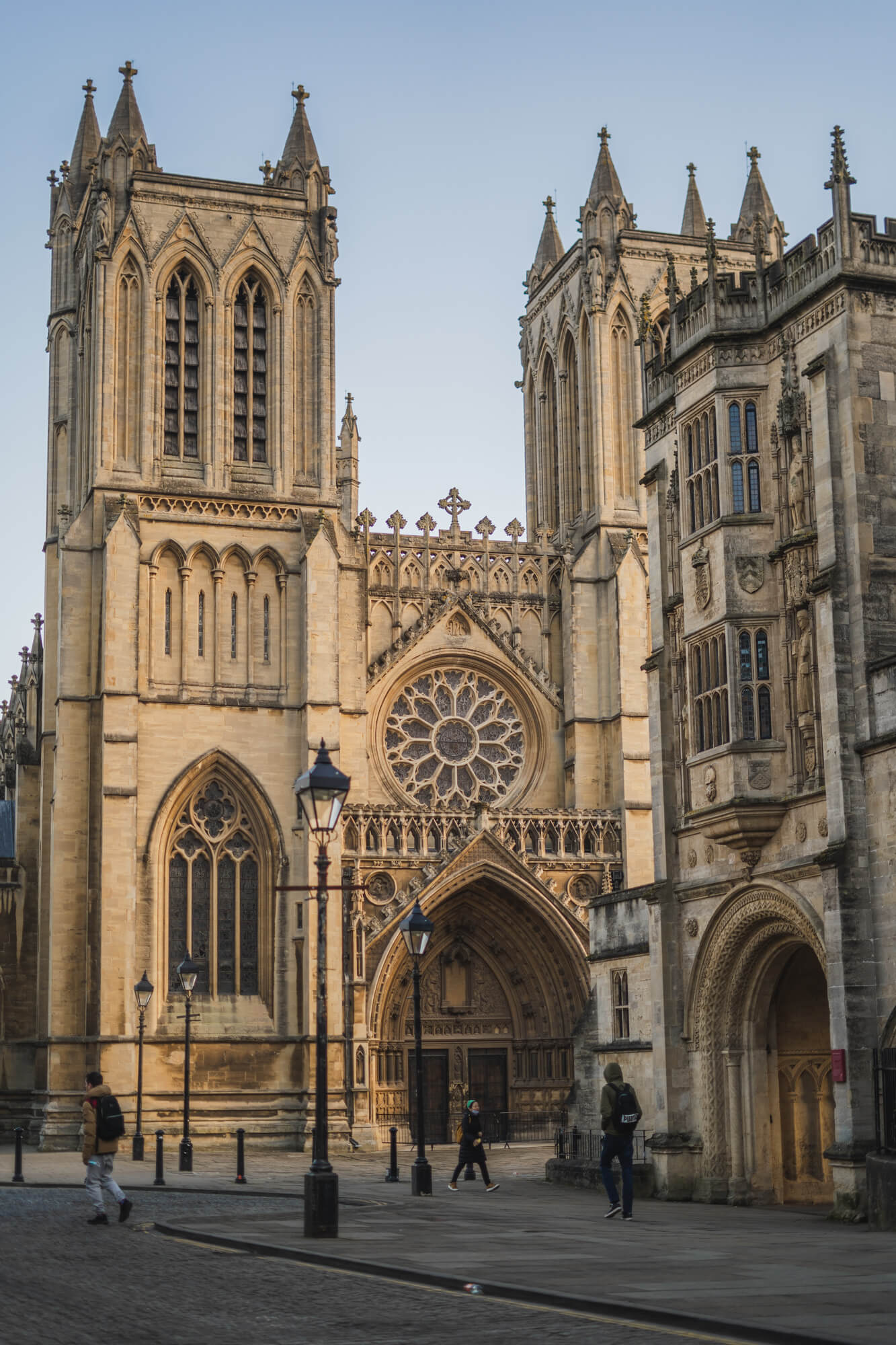
Another interesting thing about the cathedral is that it features a number of different building styles. The eastern end was built in the 12th-century while other parts were built in the English Decorated Gothic style during the 14th century and the Gothic Revival nave was added in the 19th-century.
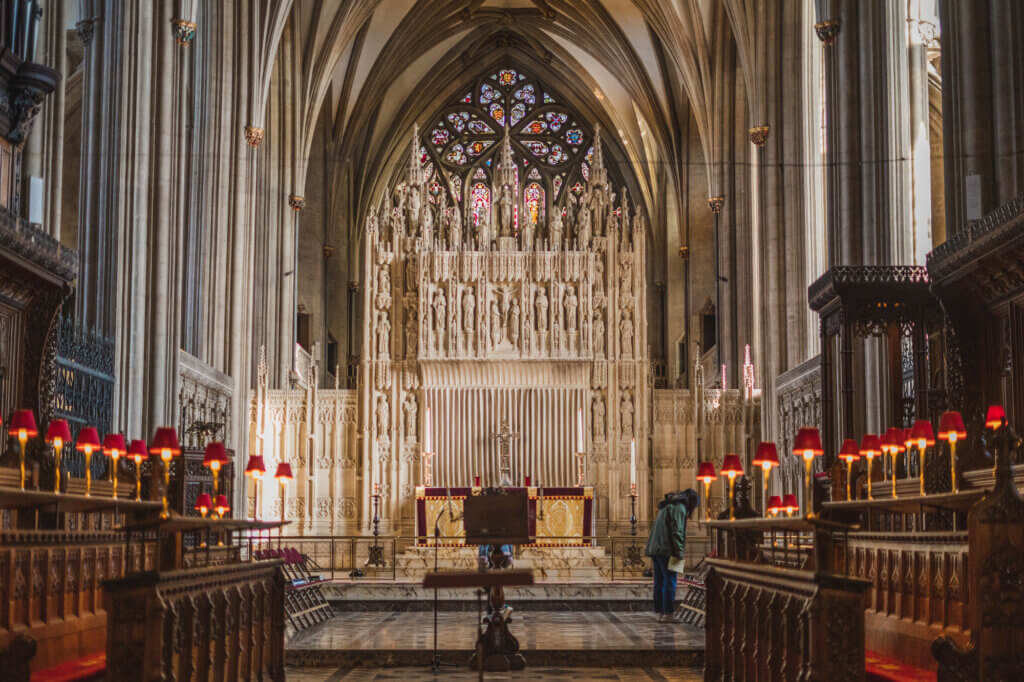
The Bristol Harbourside
The harbour area of Bristol located around the Bristol Feeder Canal is probably one of the most-visited Bristol destinations since it’s so pretty, as well as being filled with restaurants, bars, shops and hotels.
This area used to be the main dock for sailors and merchants to trade goods or stock up before long journeys of discovery. Nowadays it’s a buzzing part of the city, with locals and visitors alike soaking up the energy or partaking in fun activities. Yachting, paddle boarding, cycling and rowing can all be done in and around this vibrant neighbourhood.
Many of Bristol’s most popular attractions are located here, such as the M Shed and SS Great Britain (more on those later). The area is also packed with art centres like the Watershed, Spike Island, Arnolfini and Design West, where visitors can enjoy interactive exhibits, performances, workshops, and films.
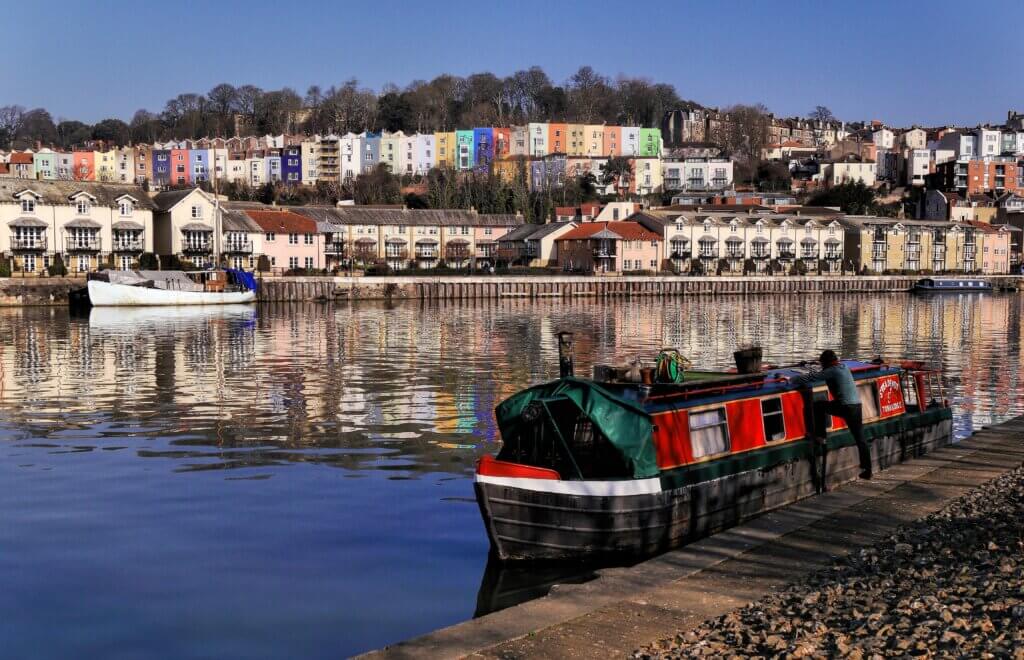
Cabot Tower
On Brandon Hill, overlooking the main harbour of Bristol, is Cabot Tower, a monument built in 1897 to commemorate John Cabot’s journey from Bristol to what would become Canada.
Cabot Tower was built 400 years after John Cabot’s famous voyage and features viewing platforms at the top of the tower which offer stunning views across Bristol if you want to climb 108 winding steps! It was constructed from red sandstone with the famous cream-coloured Bath Stone used for ornamentations.
Brandon Hill, the parkland surrounding Cabot Tower, is the oldest park in Bristol and a delightful spot to relax on sunny days. There’s a children’s play area, beautiful paths and a nature conservation area all around the tower, as well as a small pond.
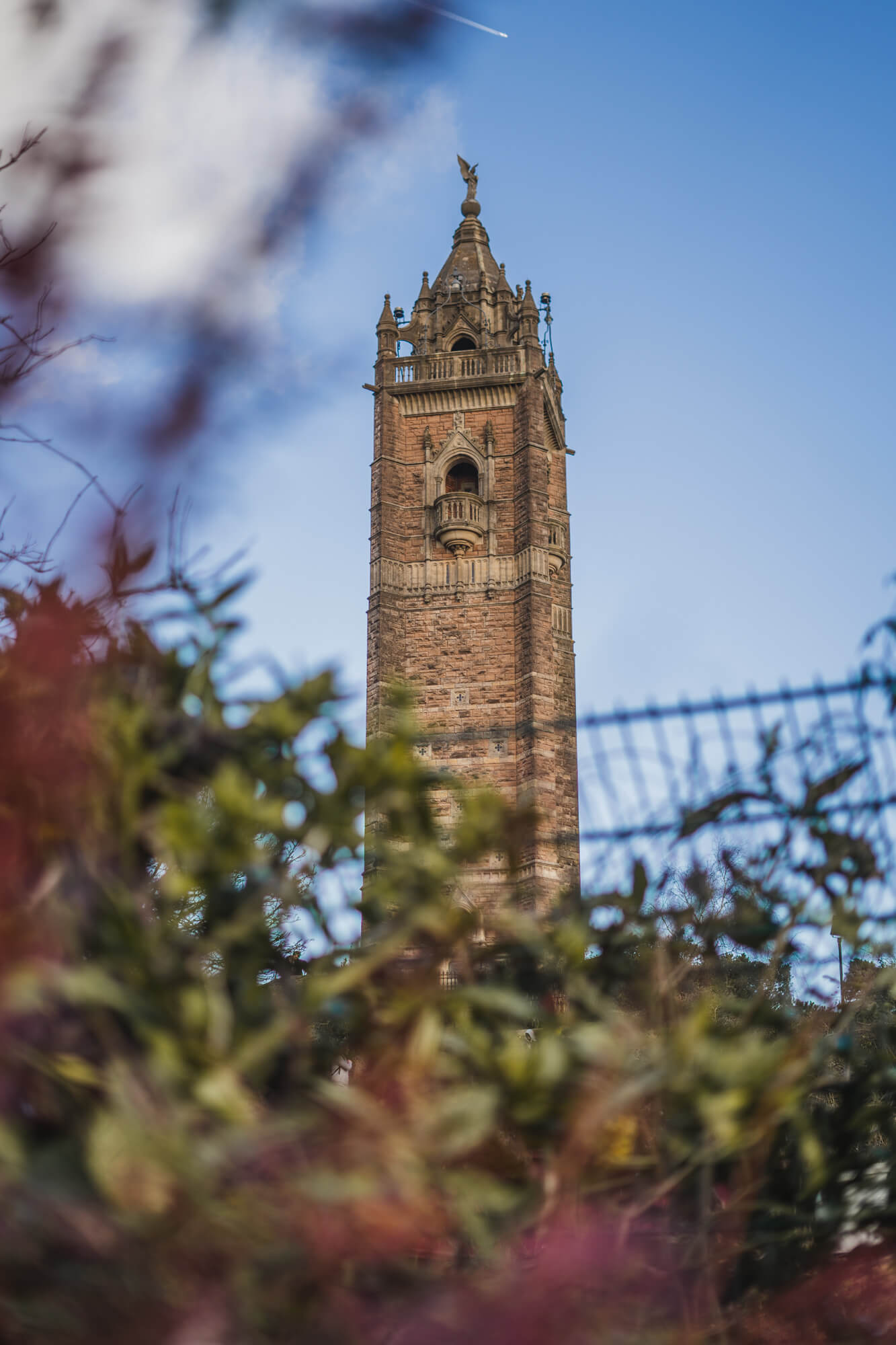
Saint Nicholas Market
Usually just called St Nick’s Market by Bristol locals, the quirky St Nicholas Market is one of the best places in the city for shopping and eating yummy food!
The market is divided into three main sections, the Georgian covered arcade, The Glass Market and the Exchange, with more than 60 stalls to explore. There are several outdoor markets regularly held in the streets adjacent to the Exchange Building as well.
The Glass Arcade section, in particular, is excellent if you like international food, with permanent food stalls showcasing cuisine from around the world. Along with all the mouth-watering treats, Saint Nicholas Market offers many opportunities to shop for beautiful jewellery, clothing, gifts, children’s toys and more.
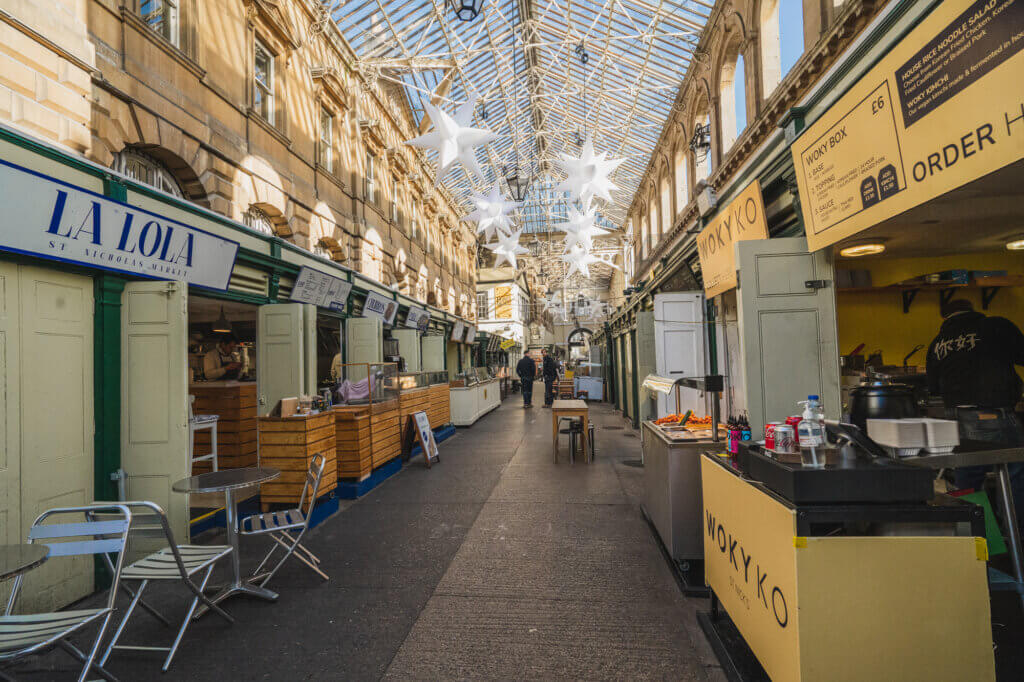
The Corn Exchange Building
Sometimes called the Corn Exchange Building and sometimes just The Exchange, this Grade I listed building was originally a corn and trade exchange but is now home to offices and part of the St Nicholas Market.
It was originally built by John Wood the Elder between 1741–43 and is now the only surviving 18th-century exchange building in England. The building is very grand, with multiple lion’s head knockers on the main doorway, Corinthian columns on the exterior and four bronze tables outside the entrance, known as nails.
These tables were used by merchants conducting trade deals, as the edges were raised to prevent coins from falling off. The four nails were all made at different times and feature slightly different designs, with the oldest thought to be from the Elizabethan era.
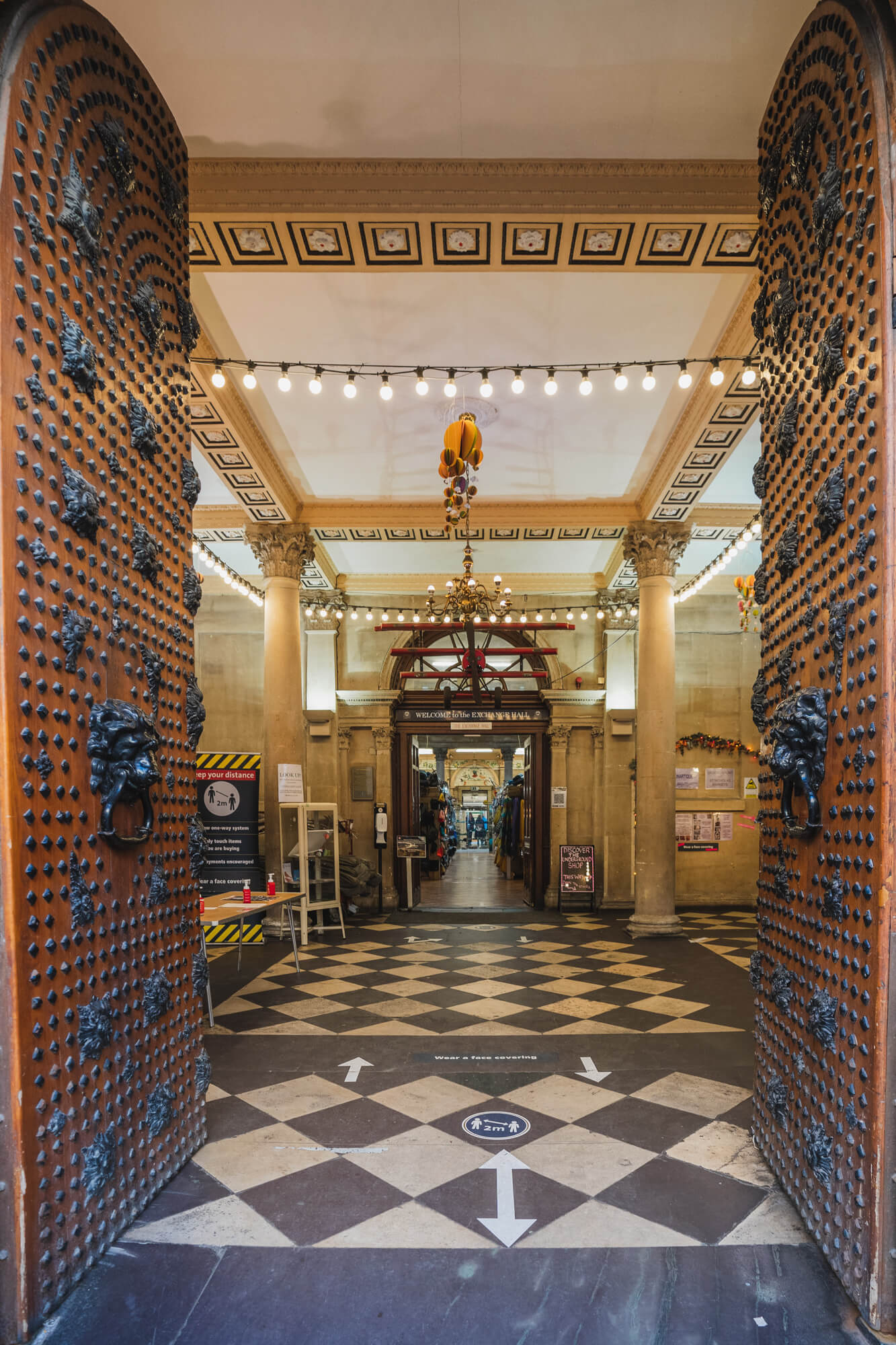
PS: Don’t miss the unique clock on the facade of the building, which has an extra minute hand for “Bristol Time”, which is ten minutes slower than Greenwich Mean Time.
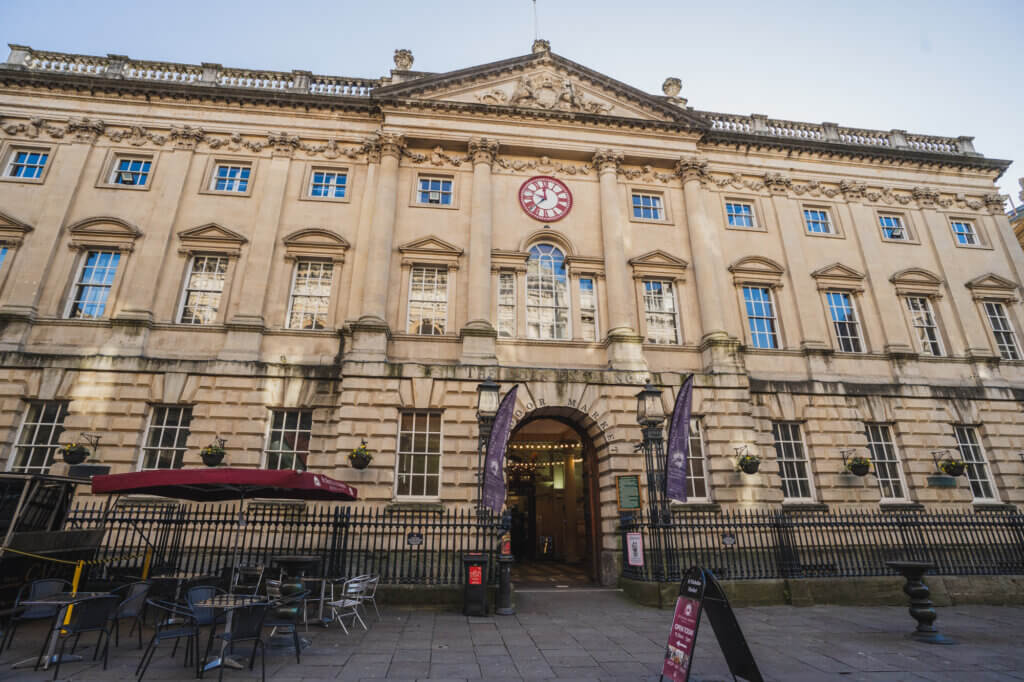
Café Revival
Directly next door to the Exchange is Bristol’s oldest coffee house, Café Revival. Not only is it the oldest coffeehouse in Bristol but it’s also got to be one of the largest, with the shop spread out over three storeys in a beautiful listed building.
There has been a coffee shop on the site since 1718. Over the years it has also been used as an office for an insurance company, but more often as a coffee shop run by multiple different people, until it was revived as the aptly named Café Revival.
On the ground floor, there is a takeaway counter and some outdoor seating, while upstairs is the main café area with tables and comfy seating. On the third floor is the ‘snug’, the cosiest area for having a coffee and some cake while perhaps reading a book on a comfy couch!
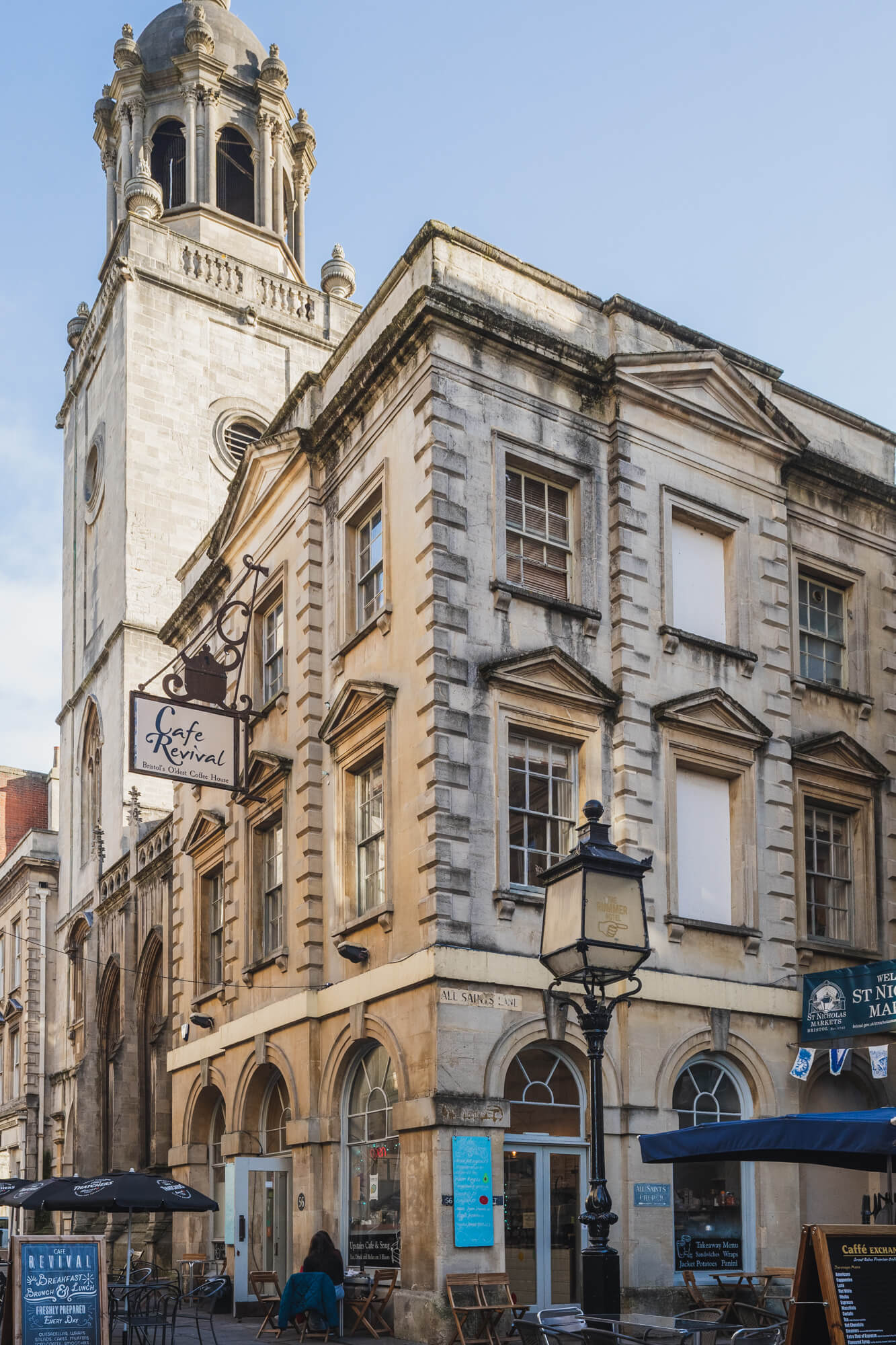
St John’s Gate
Sometimes called St John on the Wall, St John’s Gate or (officially) the Church of St John the Baptist, this unique sight in Bristol is basically a church built into the city’s medieval walls.
Like many of England’s older towns, Bristol was surrounded by a defensive wall, into which several fortified gateways were built. St John’s Gate is the only surviving one of these gateways and a church was also built into the walls above this gate in the 14th-century, with parts of it also within the wall beside the gate.
The church interior is, not surprisingly, very narrow, with the tower and steeple built directly above the gate. As you walk under the gate you can still see the portcullis channels within the arch, where the gate could be closed to defend the city.
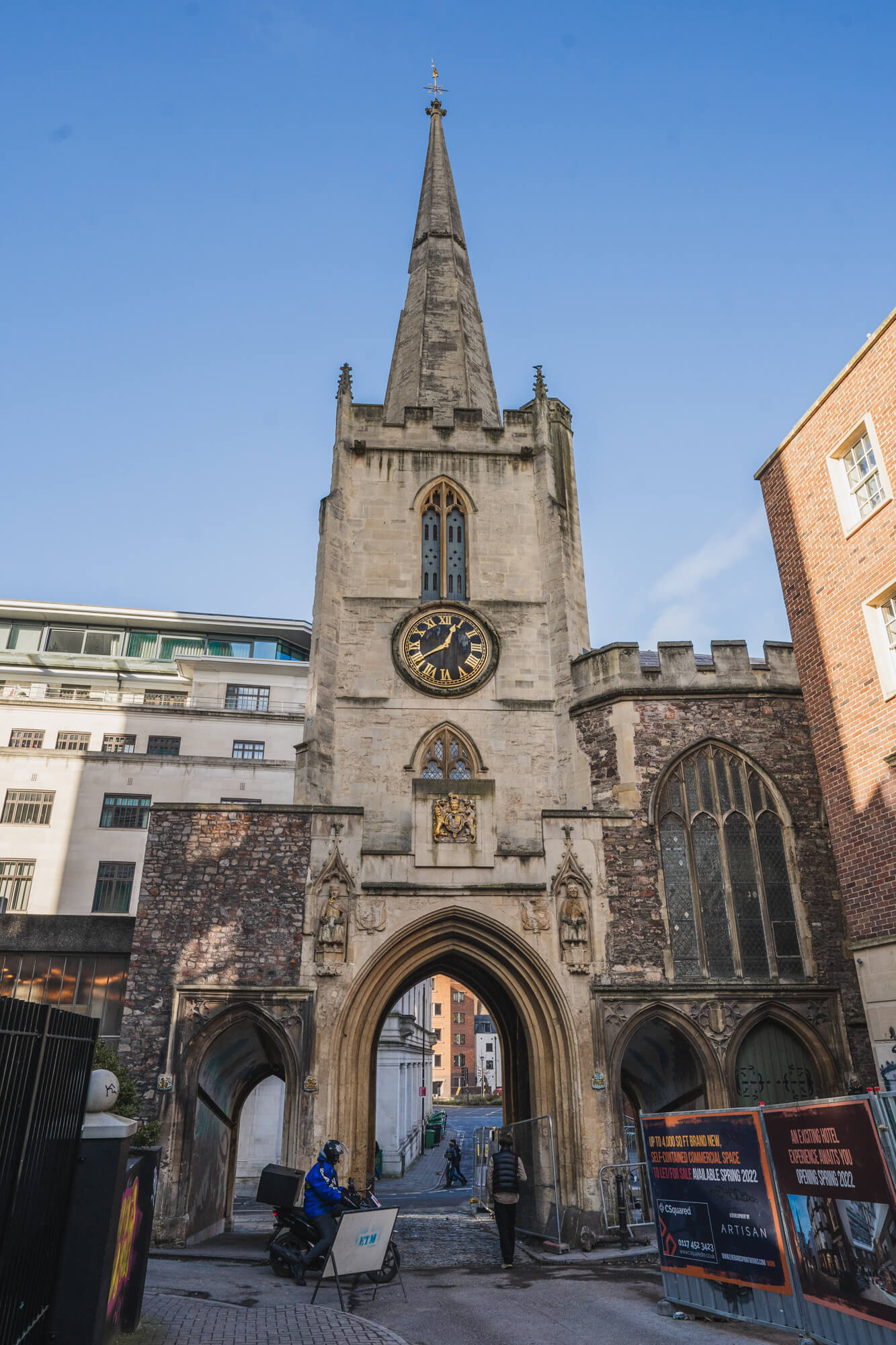
After you exit the gate and start walking on Quay Street, you’ll also be able to admire some of the large and impressive murals that Bristol is known for:
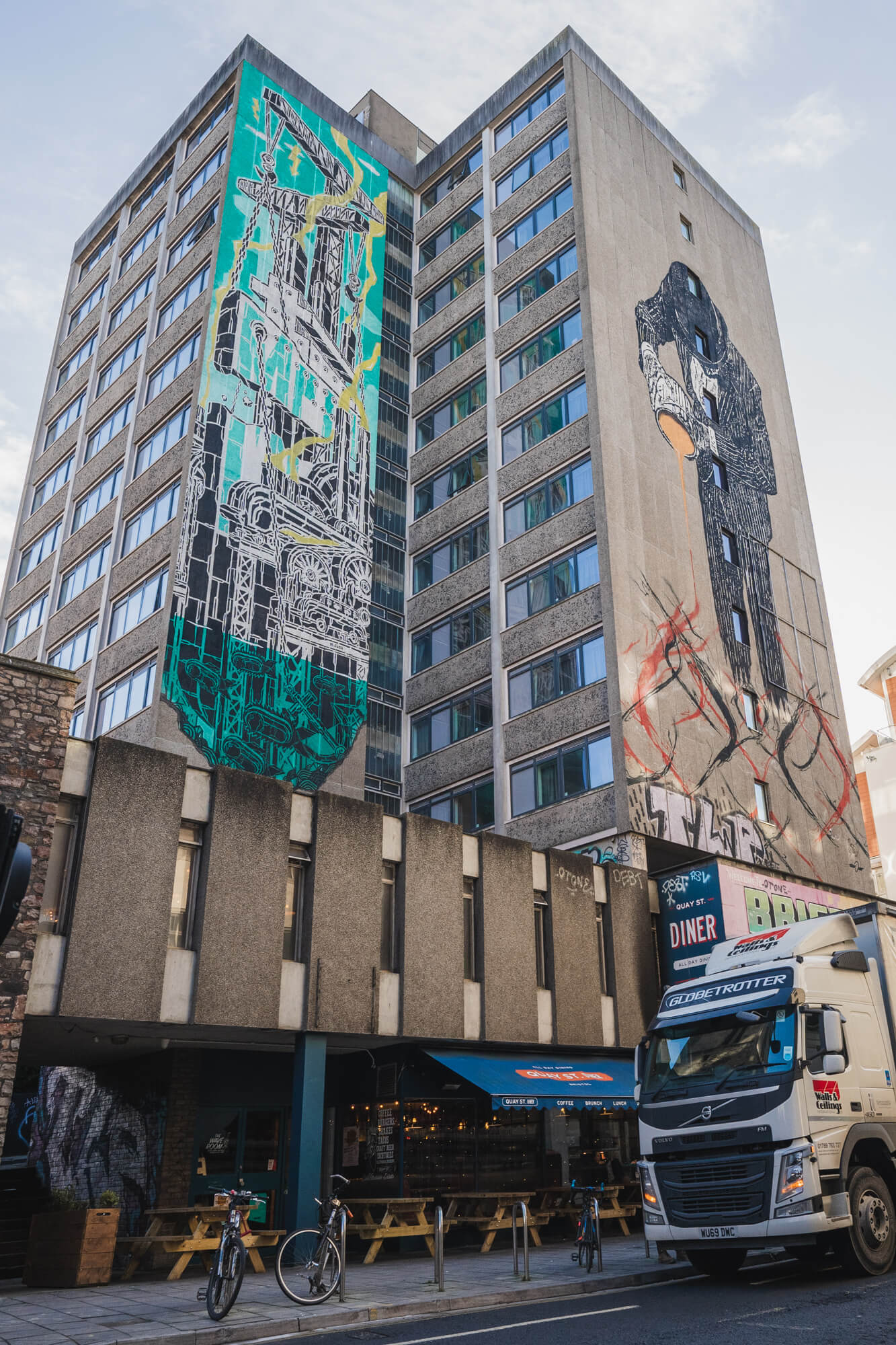
Christmas Steps
‘The Christmas Steps’ is a steep and historic stepped street in Bristol, leading from Colston Street down to Colston Avenue. This tiny street is sometimes called Bristol’s answer to the Shambles in York!
Like the Shambles, Christmas Steps is an almost hidden laneway that looks a bit like Diagon Alley, with antique shops, oil lanterns and magical fairy lights at night. It’s part of the wider Christmas Steps Arts Quarter, which is full of fascinating shops, art galleries, studios and cafés.
The street has actually had a few name changes over the years, once called Queene Street because Queen Elizabeth I apparently visited, then changed to Christmas Steps in 1775.
There are a few theories of why it’s called ‘Christmas’ Steps, although we like the one that says it was named for the Chapel of the Three Kings of Cologne which is located at the top of the street and features a stained-glass window of the nativity.
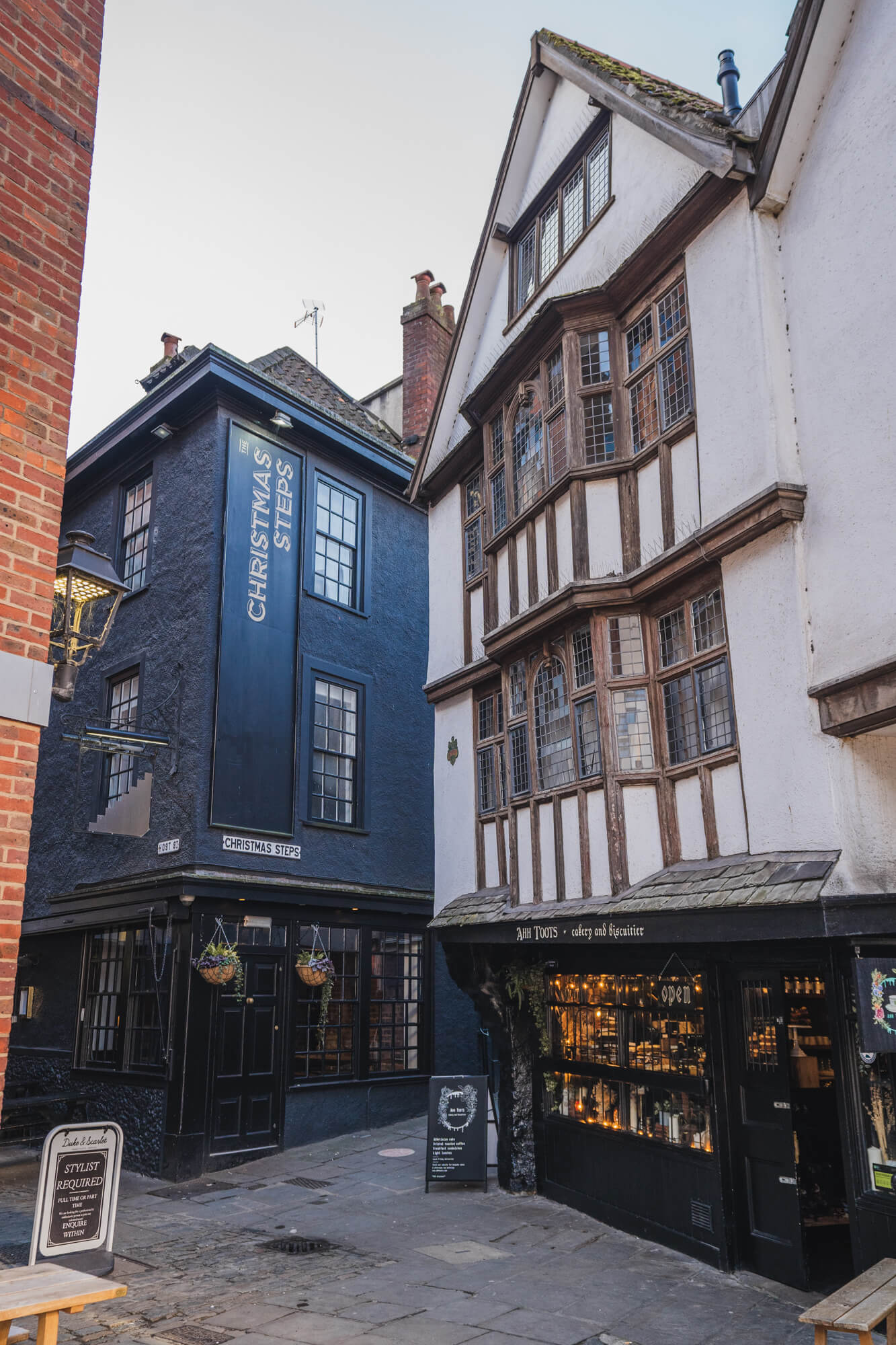
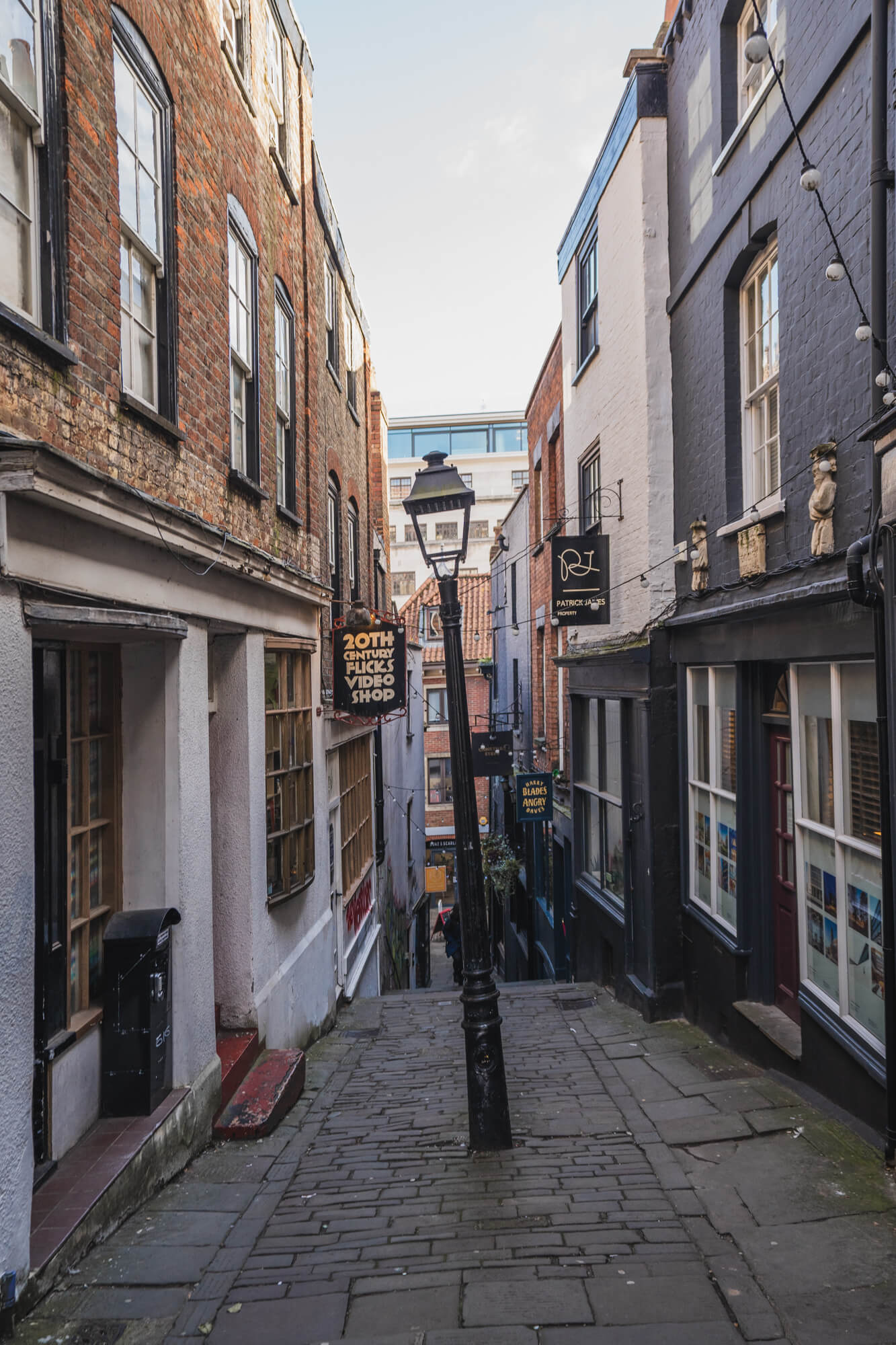
There are 11 listed buildings located on the steps, along with the cosy Christmas Steps Pub located at the bottom of the street and if you’re craving a sweet treat, AhhToots (also located at the foot of the steps) is simply a must-try!
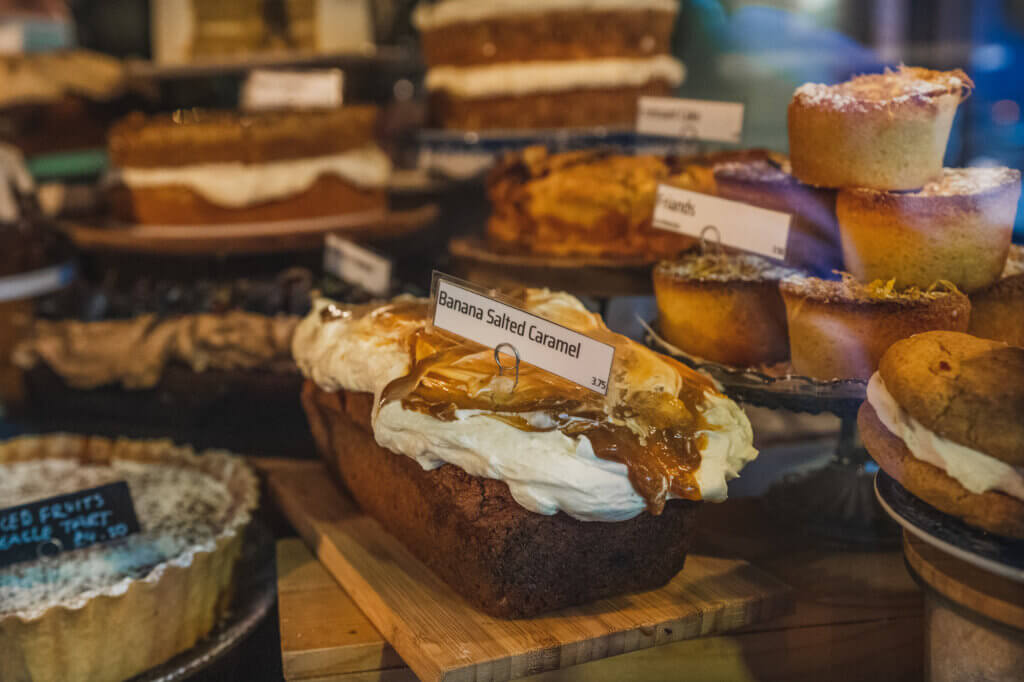
Foster’s Almshouses
At the top of Christmas Steps, directly next door to the Chapel of the Three Kings of Cologne is another fascinating Bristol building: Foster’s Almshouses, dating from 1492.
Both the chapel and almshouses were founded by John Foster, a wealthy 15th-century merchant, High Sheriff, Mayor of Bristol and Parliamentarian. These almshouses were built to provide shelter for the disadvantaged and poor elderly of Bristol. The structure is now a Grade II listed building and popular Bristol sight.
While the buildings are now private residences (so you can’t enter them) the beautiful spires, winding staircases and manicured gardens make it well worth a stop for sightseeing or to take some photos. The Chapel of the Three Kings of Cologne was actually built as a private chapel for the almshouse residents.
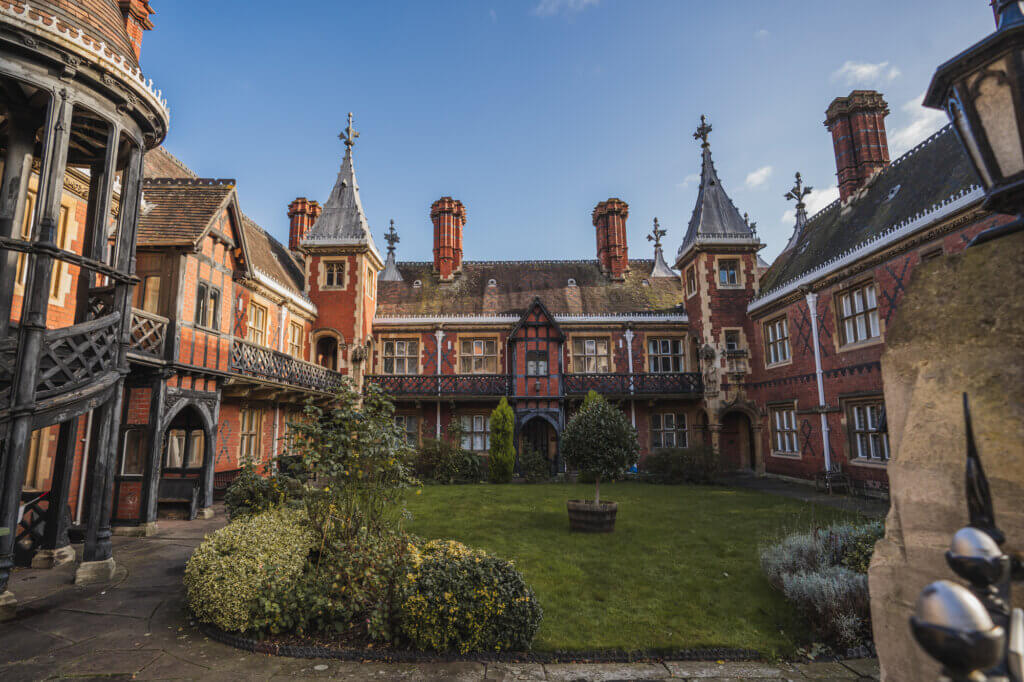
Royal York Crescent
Besides being one of the prettiest photography spots in Bristol, the Royal York Crescent also happens to be the longest terrace in Europe and one of the most expensive streets in the city.
Located in the suburb of Clifton, this majestic terrace is visible from the gorge below as well as from across the harbour. It’s made up of 46 Georgian townhouses, some of which are Grade II listed buildings. The architecture is quite interesting, with all of the main entrances opening onto a walkway, below which are garages and basements which open onto the road.
The street was built for the affluent Bristol residents to live away from the squalor of the city down by the harbour. A quick Google today shows that the buying prices for properties on the street are still comparable!
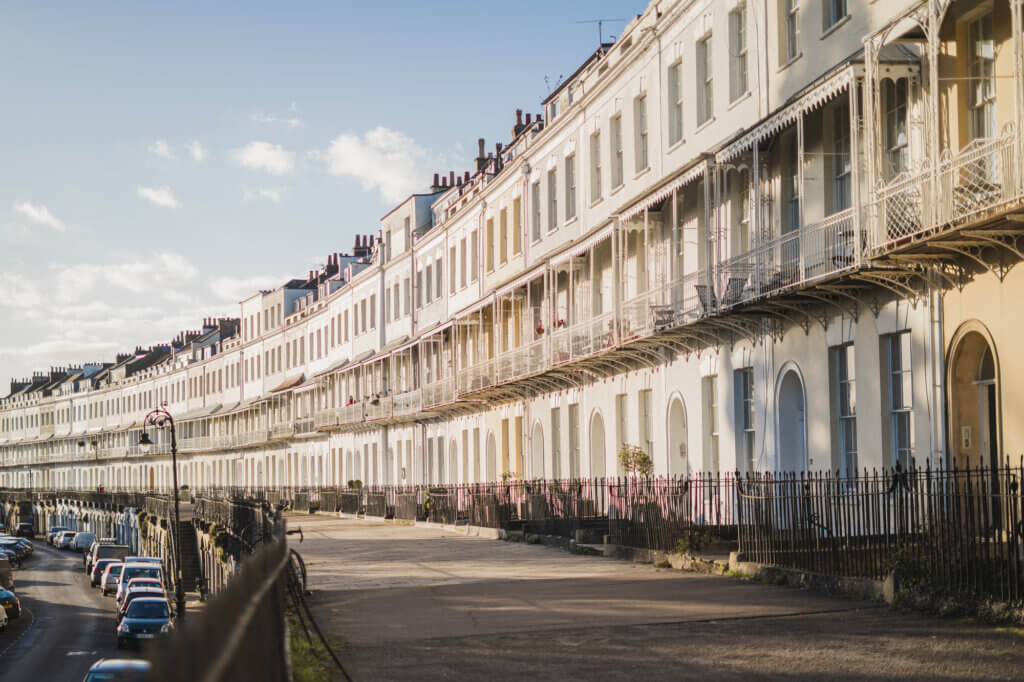
Temple Church
Located in the Bristol neighbourhood of Redcliffe, Temple Church is a ruined church on the site where there once stood a round temple of the Knights Templar.
The original temple was rebuilt around the early 14th-century into a rectangular church, which was the site of a famous exorcism in 1788. This church was later largely destroyed during the Bristol Britz in WWII but the remains are now a Grade II listed site, which attracts many tourists. Along with the remains of the 14th-century church, the plan of the 12th-century templar church can also be seen marked out on the ground.
The free-standing bell tower has a marked lean, although this is believed to be due to the soft ground underneath, rather than from damage during the blitz. Apparently, the church tower is leaning so much that it’s only one degree off from the legendary Leaning Tower of Pisa!
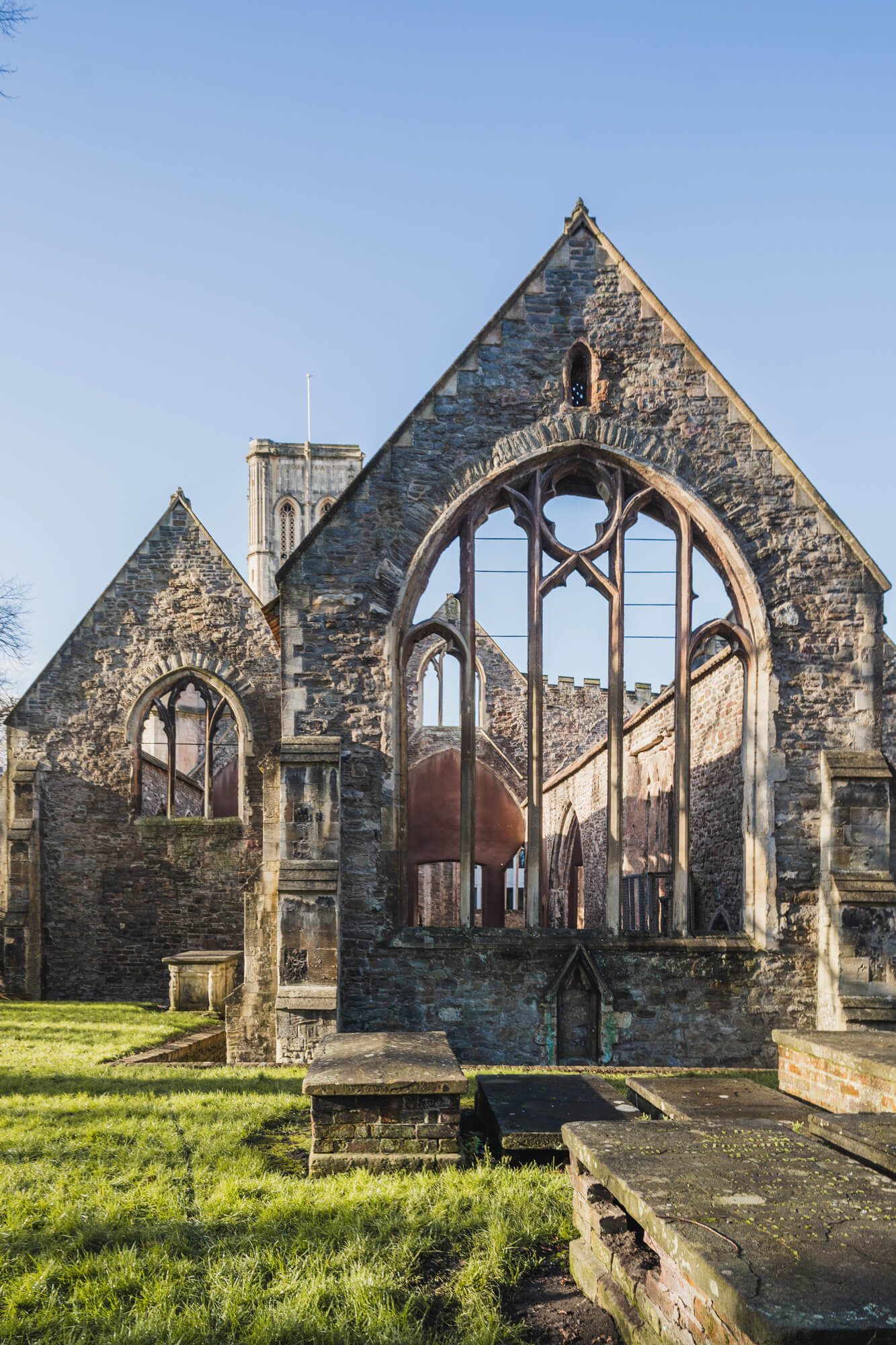
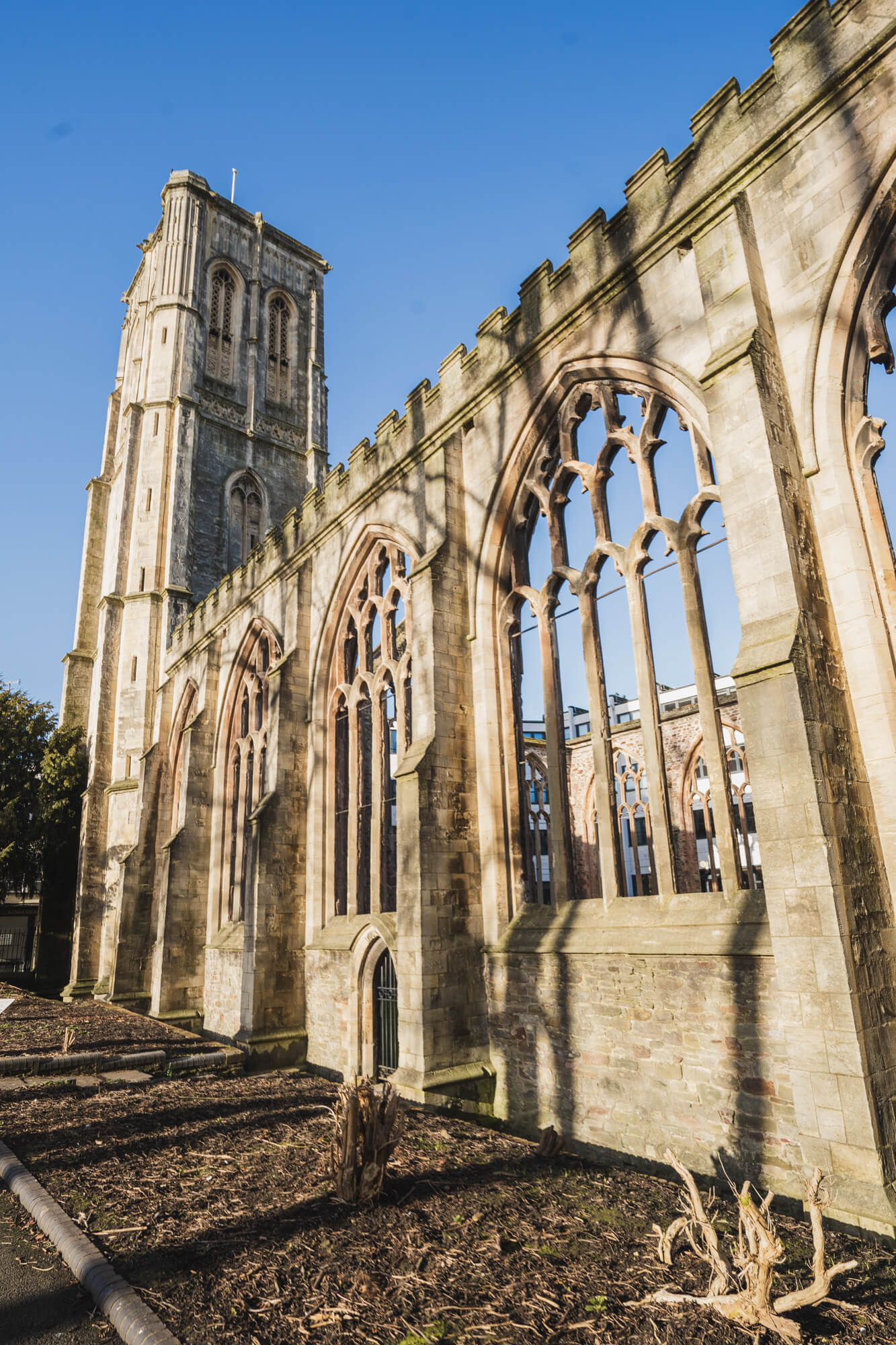
St Peter’s Church
On the opposite side of the Bristol Feeder Canal is another beautiful ruined church that attracts many visitors; St Peter’s Church, which was also bombed during WWII and is now preserved as a memorial.
St Peter’s Church was actually once an 11th-century abbey with a 12th-century tower addition and the rest of the building being added in the 15th-century. This church remained intact until the blitz, and after it was damaged the remains were kept as a monument to the civilian war dead of Bristol.
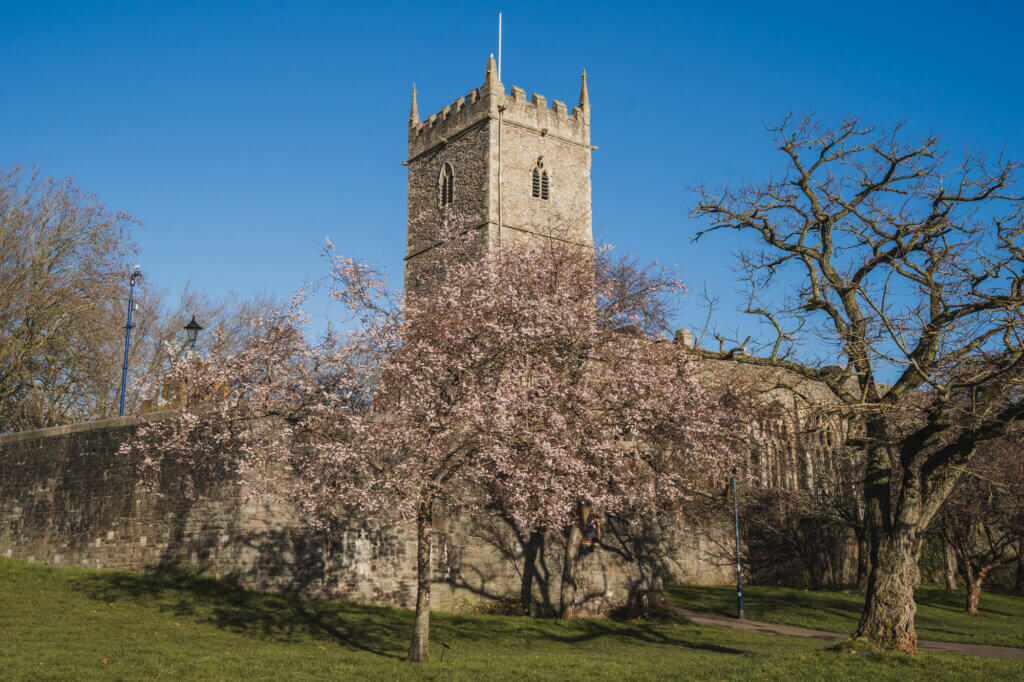
Very close to St Peter’s Church are the remains of Bristol Castle, a Norman castle that was almost completely demolished after the civil war. Castle Park encompasses both the castle ruins and church remains, along with plenty of open green spaces for the public to enjoy.
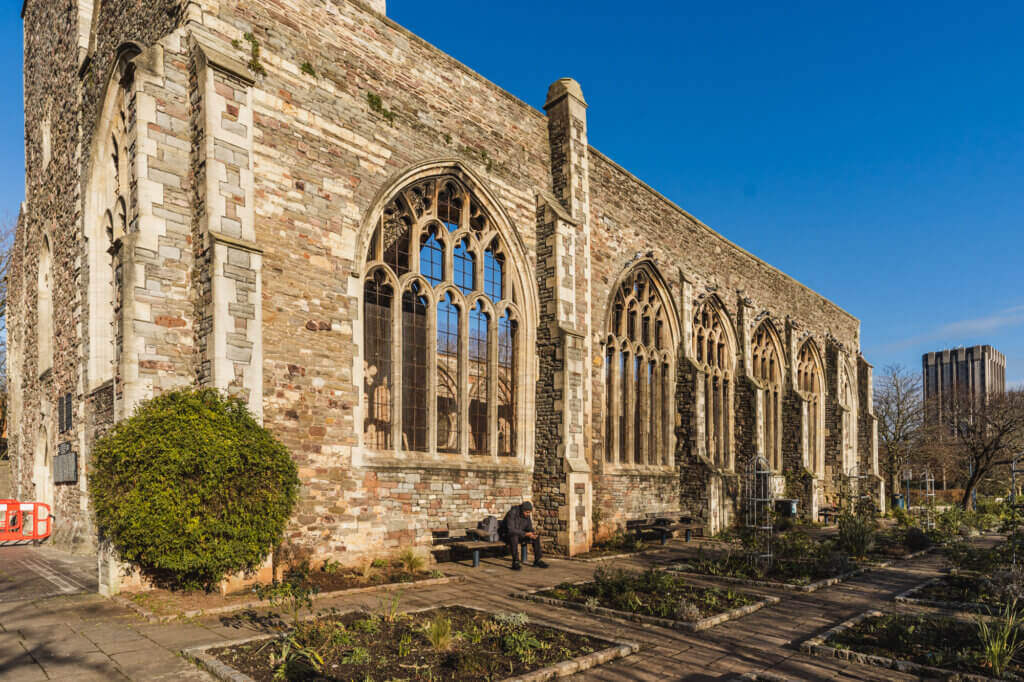
SS Great Britain
For anyone even vaguely interested in maritime history and ships, the SS Great Britain is probably one of the coolest things to see in Bristol.
Also sometimes called Brunel’s SS Great Britain, this former passenger steamship is now a museum ship back in its homeport, after being restored in 1970. Designed by the famous English engineer Isambard Kingdom Brunel, the SS Great Britain was the first iron steamer to cross the Atlantic Ocean and was also the largest passenger ship in the world between 1845 to 1854.
The ship was later used to carry emigrants to Australia in the 1850s, before being retired to the Falkland Islands in 1884 and then scuttled (deliberately sunk) in 1937. Sir Jack Arnold Hayward paid for her to be raised, repaired and returned to Bristol, where she is now a very unique museum to explore!
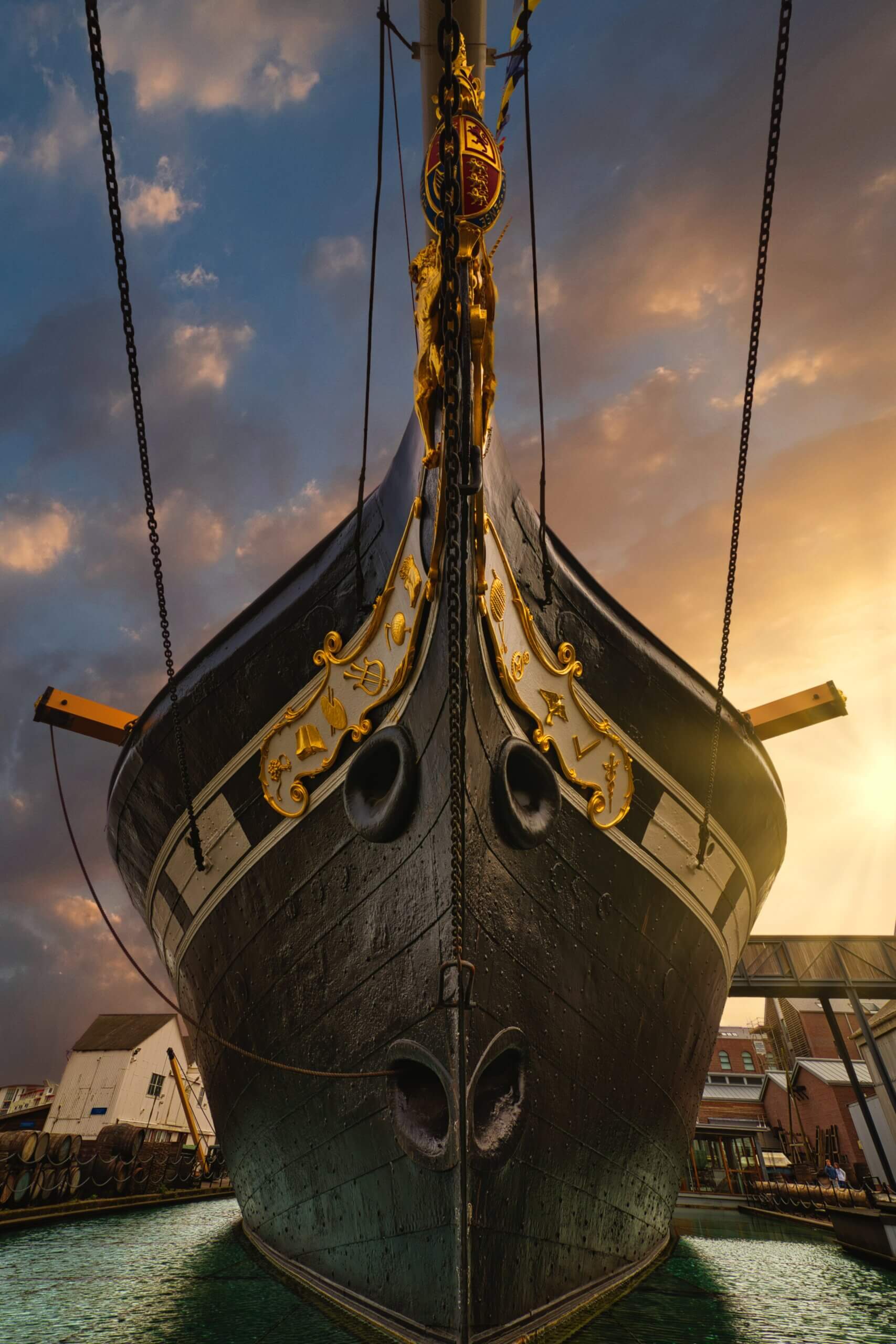
M Shed
Speaking of museums, the other must-see Bristol museum has got to be the M Shed, a museum all about the history of the city located inside a 1950s dockside transit shed on Princes Wharf.
There are stories and exhibits on life in the area dating from prehistoric times all the way up to the 21st-century.
Some of the objects on display include models of Wallace & Gromit (who were created in Bristol), spray-painted record decks from the Bristol band Massive Attack, a pixelated portrait by Bristol artist Banksy and a huge mural by two other local artists showing Bristol’s buildings as a graffiti-esque dinosaur!
Along with the many exhibits inside the shed, the museum also includes a number of historic boats, steam trains and cranes located outside. On some weekends, you can even enjoy rides on these steam trains!
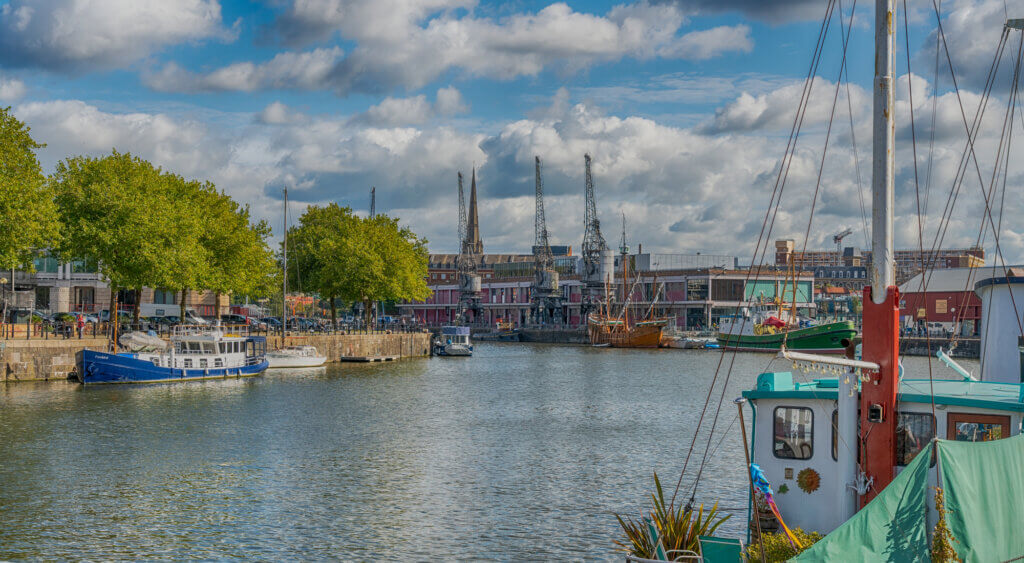
The Matthew of Bristol
A few steps from the M Shed is the Mathew of Bristol, a replica of the ship that John Cabot sailed on to North America in 1497. John Cabot was actually an Italian navigator and explorer named Giovanni Caboto, but it was common to ‘nativize’ names for the country they were in, so he’s usually named John Cabot by English speakers to this day.
Cabot is the earliest-known European to travel to North America since the Vikings did it in the 11th-century, so there are many monuments to him in both Bristol and locations in Canada. There’s even a replica of The Matthew in Newfoundland as well as the one in Bristol!
The Matthew of Bristol is usually moored outside the M Shed, but it’s also possible to sail on her around the harbour and even further along the River Avon. If you’re prone to seasickness though, you may just want to stick to a tour of the decks.
University of Bristol Botanic Gardens
The local university’s botanic gardens are one of the prettiest places to go in Bristol, especially if you need a break from all the maritime history and attractions!
They’re located a little north of the city in the neighbourhood of Stoke Bishop, which is adjacent to Clifton. A visit is definitely worth the trip though, particularly if you enjoy exploring pretty gardens. There are 4,500 species of plants on display in different sections, along with 640 square metres of greenhouses to grow plants from warm-temperate, sub-tropic and tropical zones.
Heading into the greenhouses gives you the impression of travelling to the Amazon rainforest or the Highveld in South Africa, all without leaving Bristol! There are also special collections of rare plants, medicinal herbs and the largest collection of the beautiful Sacred Lotus in the UK.
Vale Street
For one of the most unusual places to visit in Bristol, head to Vale Street near Arno’s Court Park… though be warned: this residential street has been named the steepest residential street in England, so a walk up (or down) it is not for the faint-hearted.
Located within the aptly named suburb of Totterdown, Vale Street has about a 22-degree gradient incline and it’s reported that when it’s icy, residents need to tie their cars to poles to prevent them from sliding down!
Apparently, locals also hold an annual Easter egg race, where they roll eggs from the top of the hill and the winner is whoever’s egg goes furthest. It might be a challenge to live on Vale Street but it also sounds rather fun.
Did we miss any of your favourite places to visit in Bristol?
Let us know in the comments so we can add more Bristol must-sees to the list!
